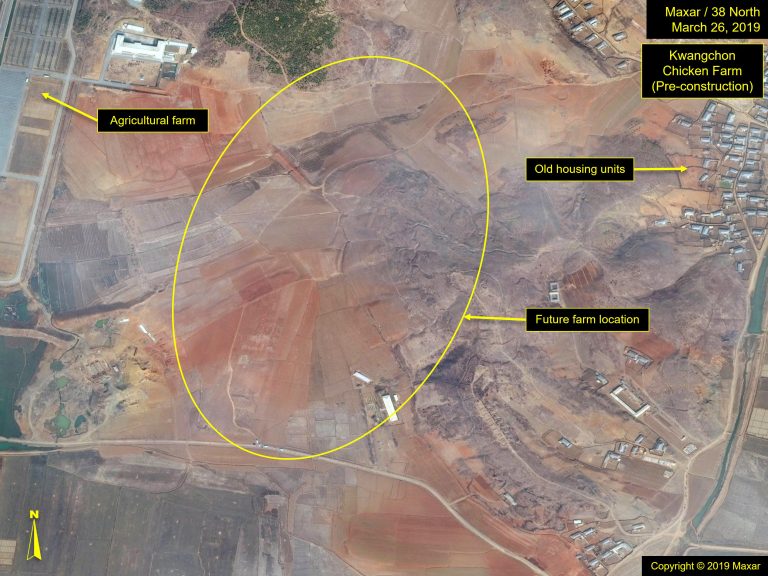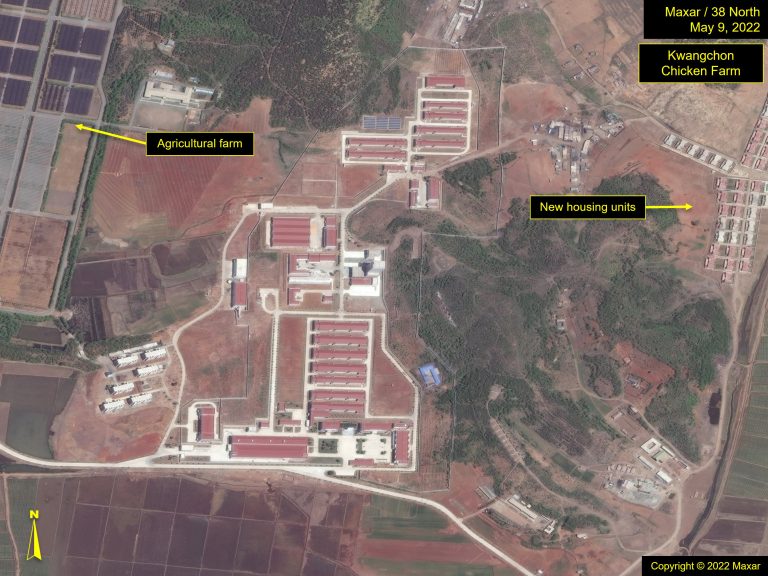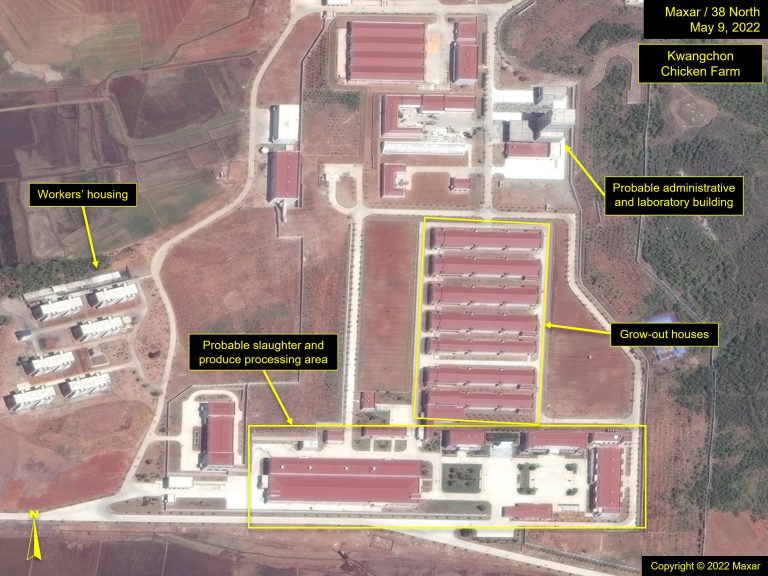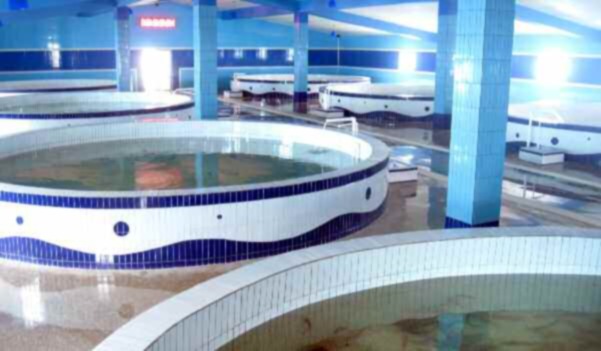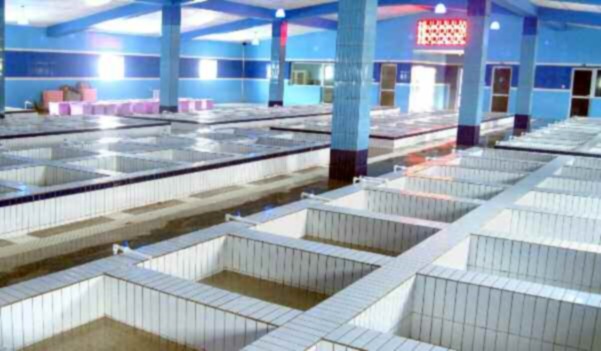North Korea’s Animal Protein Farming: Expansion Status and Challenges
While North Korean diets have historically been plant-heavy, there have been efforts to increase the availability of protein sources, especially since 2005. Despite these efforts, structural and practical limitations prevent major protein farming expansion, including the competition for food stocks, resources and land allocations, much less the ability to acquire seed animals and raise them.
Moreover, while the number of farms has been growing, giving a sense of an increasing capacity to produce protein domestically, the actual performance of these operations is unclear from satellite imagery. While new farms and buildings can be observed, especially at the exemplar farms, efforts to modernize or expand older farms are not as apparent, raising questions about the sustainability of these efforts in the long term.
Geospatial intelligence (GEOINT) shows building expansion at several showcase and exemplar facilities and farms, but judging the level of stock or output is difficult from satellite imagery alone. However, expansion and construction activity does provide data points on broad trends and intended goals.
Background
Trying to assess the food situation in North Korea is a perennial discourse, with chronic shortages reported each year. In normal years, humanitarian aid and the import of foodstuffs help supplement domestic production, making shortages less pronounced, especially for those who have access to markets and income to spend. Moreover, imports of agricultural products such as seeds and fertilizers help increase the resiliency of domestic farming against increasingly unpredictable and sometimes extreme weather conditions. However, since the country’s self-imposed pandemic isolation, domestic food production has become more important. The lack of major imports and assistance since 2020 has raised serious concerns over food security in North Korea and the potential for a humanitarian crisis.
While cereals and grains are a major focus of food assessments in North Korea, protein sources are an equally important part of the equation. Prior to 2000, except for North Korea’s elites, the country subsisted principally on vegetarian diets. To have meat as few as two to three times a year was the apparent norm. Under Kim Jong Il, that began to change as efforts to expand the availability of animal protein to more of the population began around 2005. Under Kim Jong Un, there has been an even greater emphasis on animal husbandry, including poultry, pig, rabbit and larger grazing animals such as sheep, goats and cattle.
Of the domestic farms, pigs, poultry (primarily chickens) and rabbits appear to lead the way in production, but more recently, the numbers of sheep, goats and cattle farms have increased. The former group requires less space to house and raise, but those animals also compete for many of the same food stocks (primarily grains) that humans consume.
Types of Protein Production Initiatives
Livestock Farming
The livestock co-ops specialize in a variety of domestic animals that are generally housed in large barn complexes, most of which have existed for decades with little outward change aside from building maintenance. Thus, despite official DPRK claims regarding improvements made in its farming productivity, these changes cannot be effectively corroborated or assessed through methods, such as satellite imagery analysis, unless new farms are built, or new buildings are added to existing farms.
The exception is the more recent developments within North Korea’s northeastern steppe lands region. There, over 300 livestock farms and facilities have sprung up , and thanks to North Korea’s propensity to favor common architectural designs for these farms and farmworkers’ housing, the newly constructed farms provide cookie-cutter-like signatures, making each type of farm easy to identify and record.
However, even in these cases, estimating the number of animals per farm is nearly impossible based on satellite imagery alone, especially with infrequent captures. For instance, while there has been a clear growth in the number of these farms, it is unclear how close any of them are to being fully stocked. Moreover, the reproduction rate of the larger grazing animals falls well short of that of smaller animals such as poultry and rabbits, making it challenging to obtain an accurate account of how much the stock itself grows alongside the farms. Therefore, determining when a particular farm could or has reached full capacity can only be estimated if the number of seed animals present at the time of the farm’s completion is known.
Fish Farms and Fisheries
Fish farms and fisheries provide a crucial source of animal protein to North Koreans, especially those who live near the coast. Satellite imagery has been able to identify a substantive growth in the number of hatcheries and aquaculture farms that can be found inland in lakes, rivers, ponds and rice paddies, as well as along the coast.
“Fisheries” refers to the catching and processing of ocean-caught fish. Both east and west coasts hold a number of these, though more are located on the country’s east coast. The processing facilities are easily identified by the presence of dozens of small fishing boats and/or larger trawlers.
While the growth in the number of fish farms and hatcheries has been relatively easy to assess, the fisheries, all of which have also been in existence for decades, offer few signatures to corroborate growth, such as the addition of a new building or two. The presence of fishing vessels helps mark their locations, but the counting of the fishing boats present does not necessarily translate into being able to forecast the size of the annual catch or whether new fishing techniques have been employed. Furthermore, often large numbers of small boats appear to remain idle in basins and at the mouths of rivers for months at a time, leaving the analyst to wonder if this seeming inactivity is tied to when the fish are running or whether many of the smaller boats have given way to larger, more efficient trawlers.
Chicken Farming
In reviewing the many known livestock farms in North Korea, chicken farms seem to be prevalent. Chickens are some of the easiest forms of protein to raise, and their numbers can be increased rather quickly, provided their slaughter is closely managed. While chicken farming represents the majority of the country’s poultry farms, duck and goose farms cannot be overlooked.
Chickens offer two reliable types of protein sources, eggs and meat, the farming of which requires somewhat different handling conditions. This explains why a chicken farm may have several different-sized building layouts. Certain buildings are designated for egg production, some are for breeding and incubation (approximately 25 days in the shell), and yet others are referred to as “grow-out” houses for the broilers.[1] Because these are co-op farms, they are likely to have processing buildings designated for either egg packaging or slaughter and packing.
Chickens, as a rule, are raised in large coops, in open yards, or are free range. The latter is the least economical, and while open yards with small coops would seem most desirable, they are also more likely to contract diseases.
Without specific farm data, only rough estimates can be made as to how many chickens a particular farm can house. All animals require a minimum amount of space for a moderately healthy life. In this case, grow-out houses of approximately 16,000 square feet can house as many as 20,000 chickens. Unfortunately, whether North Korea has achieved this maximum capacity at any of its chicken farms is unknown, as well as whether it holds to this occupancy standard.
Large, co-op chicken farms are located throughout the country, but the majority appear to be in the more fertile western regions. Of the 35 chicken farms identified in 38 North’s Digital Atlas, only five are located along the east coast and three in the central, northern part of the country. Little commercial satellite imagery is available prior to 2005, but it seems that most of the present farms predate that year. Of those identified, few have signs of growth in terms of building footprints, and in some cases, a few of the farms have shown a decline. Whether the latter is due to climatic conditions at their location is unknown.
Kwangchon Chicken Farm
The Kwangchon Chicken Farm is an exception to the aforementioned trend and was built in recent years. Located south of Pyongyang, it has been featured in a number of official news reports touting the innovations being applied to make it a showcase farm.
The farm was built between 2018 and 2021, with a notable increase in activity after an April 2022 visit to the site by Premier Kim Tok Hun. In addition to the farm activity, the surrounding countryside has also shown dramatic signs of renewal, as older, substandard housing units have given way to new and modern apartments, schools and social welfare centers. Not all of this renewal necessarily supports chicken farming, as the area is conducive to the growing of crops as well.
The Kwangchon Chicken Farm is clearly meant to be a model farm. There are 13 hen houses of different sizes, suggesting their different functions—breeding, egg production and grow-out houses. There are several support buildings on site, among them a probable incubation building, an egg processing building and a slaughter and meat processing building. There is a five-story building, which likely houses administrative and scientific laboratory functions. There are also six apartment houses on the premises for an on-site workforce, while additional, newly constructed apartments are located nearby should they be needed (Figure 1a-c).
Given the total square footage of the farm, it appears to be capable of accommodating as many as 170,000 chickens. How many are actually housed there is currently unknown and would require ground photos to assess.
In July 2020, Kim Jong Un visited the Kwangchon Chicken Farm and declared it a new model chicken farm that will provide “significant contributions to the dietary life of our people.” With this, he announced the farm to produce “thousands of tons of delicious and quality meat and tens of millions of tasty and quality eggs every year.”
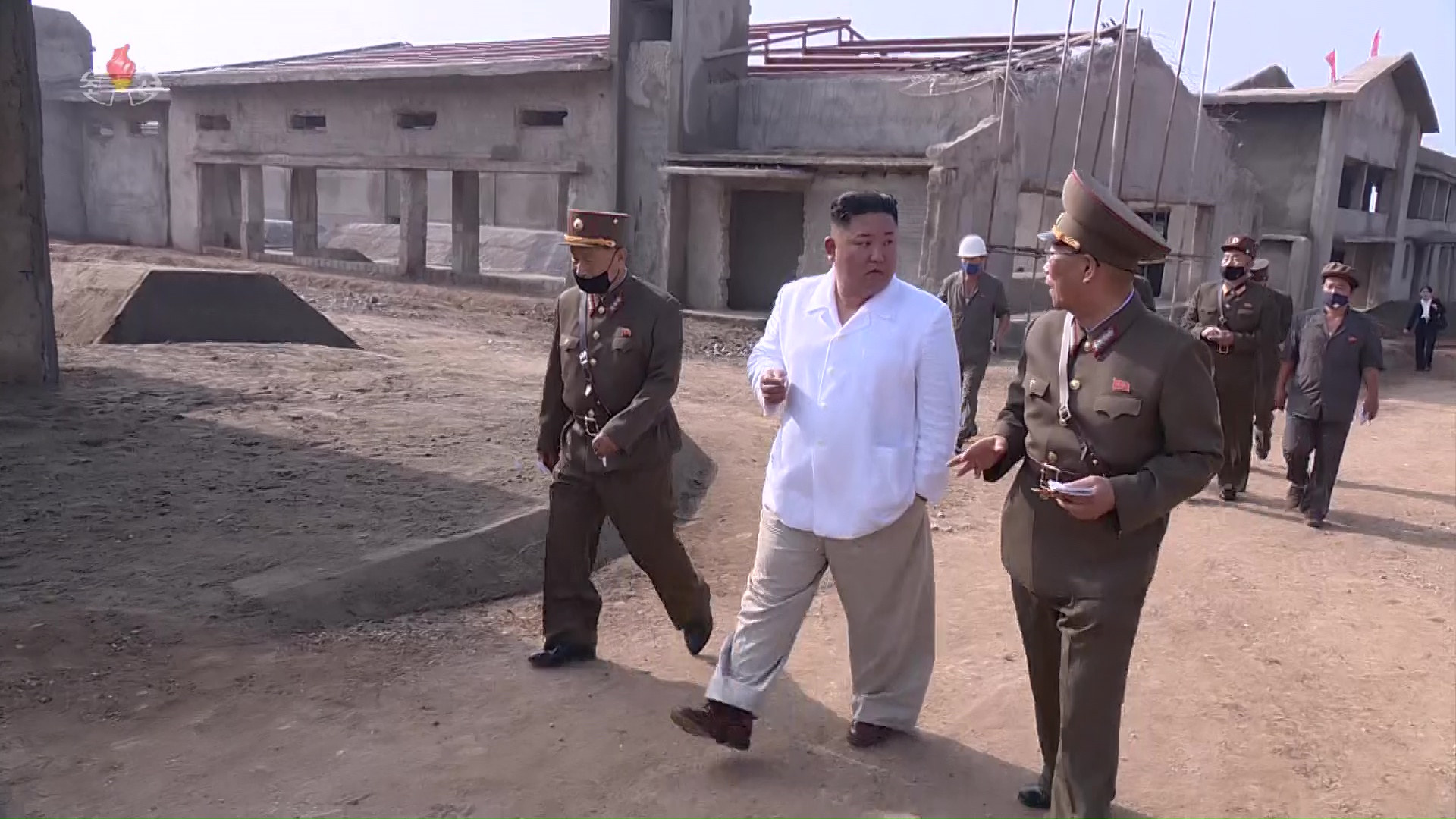
To meet this goal would require several tens of thousands of chickens. Healthy, well-fed hens can typically lay five to seven eggs per week on average, totaling somewhere between 200-300 eggs per year per hen. This would necessitate—with generous estimates—over 30,000 chickens.
State media suggests that the modernization efforts implemented at the Kwangchon Chicken Farm lend themselves to increasing and innovating feed production. The following year, the Kusong and Sinuiju Chicken Farms were mentioned in state media as remodeled farms, presumably with similar modernization features. Some of these improvements include the establishment of fermented feed production and additive lines, combined feed processing and breeding grounds for other crops to turn into feed for the chickens. As recently as March 2023, the Sinuiju Chicken Farm was mentioned as continuing to improve its “circular rotation production system” and to “perfect the automatic control system” to fulfill the national economic plan.
Rabbit Farming
The raising of rabbits for meat protein was promoted as an economical solution when first introduced. Young students were While many farms may have been started, it is difficult to determine the extent of its adoption. Because the imagery signature for these farms can be confused for other livestock farms, apart from those that have been confirmed via other sources, obtaining an accurate number of these farms is not possible. That said, the number of confirmed farms suggests their numbers are far fewer than the known poultry farms. Whether this is because poultry is more easily farmed or rabbit is not a preferred meat of choice is unknown.
The life cycle of rabbits differs from that of poultry. They require more space per animal to raise, approximately 10 to 15 square feet. Their gestation period is approximately a month, with litters of five kittens being typical. The kittens can be harvested for both meat and pelts at about three months but do not reproduce until around six months.
Most of the known rabbit farms were built prior to 2005. In addition to larger breeding farms, Kim Jong Un has also encouraged households to undertake “private livestock farming” to increase production without large investment from the state. When rabbit farms are mentioned in state media outlets, most are labeled as “rabbit breeding farms.” An emphasis is placed on feed production for the animals, along with anti-epidemic measures such as preventive medication to halt disease from spreading and affecting swaths of the stock. Rabbit feed has been mentioned as utilizing rice, dried grass and beans—emphasizing both the interconnectivity of protein production and agricultural output and the potential conflicts that may arise in prioritizing crop allocations when food is scarce.
In sum, while rabbit farming appears to continue, efforts to expand this protein source seem to have stopped.
Phyongwon Rabbit Farm
The Phyongwon Rabbit Farm provides a typical layout for the larger rabbit farms and has been frequently mentioned in state media. The farm predates the first available satellite image available from 2003. At that time, the farm consisted of six long, narrow buildings, one long and slightly wider building, and a couple of small support buildings. The larger building is likely a breeding house, where rabbits are probably artificially inseminated, as that is a more efficient process. The doe is kept with her kittens until weaned, and then the kittens are moved to the “grow-out” houses.
Phyongwon has undergone several changes over the past two decades in terms of the building numbers and locations within the compound, but its overall capacity does not appear to have been significantly altered. For example, in 2004, four of the probable grow-out houses had been razed, but four others were added, keeping the number of grow-out houses at six (Figure 3.). However, a second probable breeding house was added, suggesting a doubling of the farm’s breeding capacity.
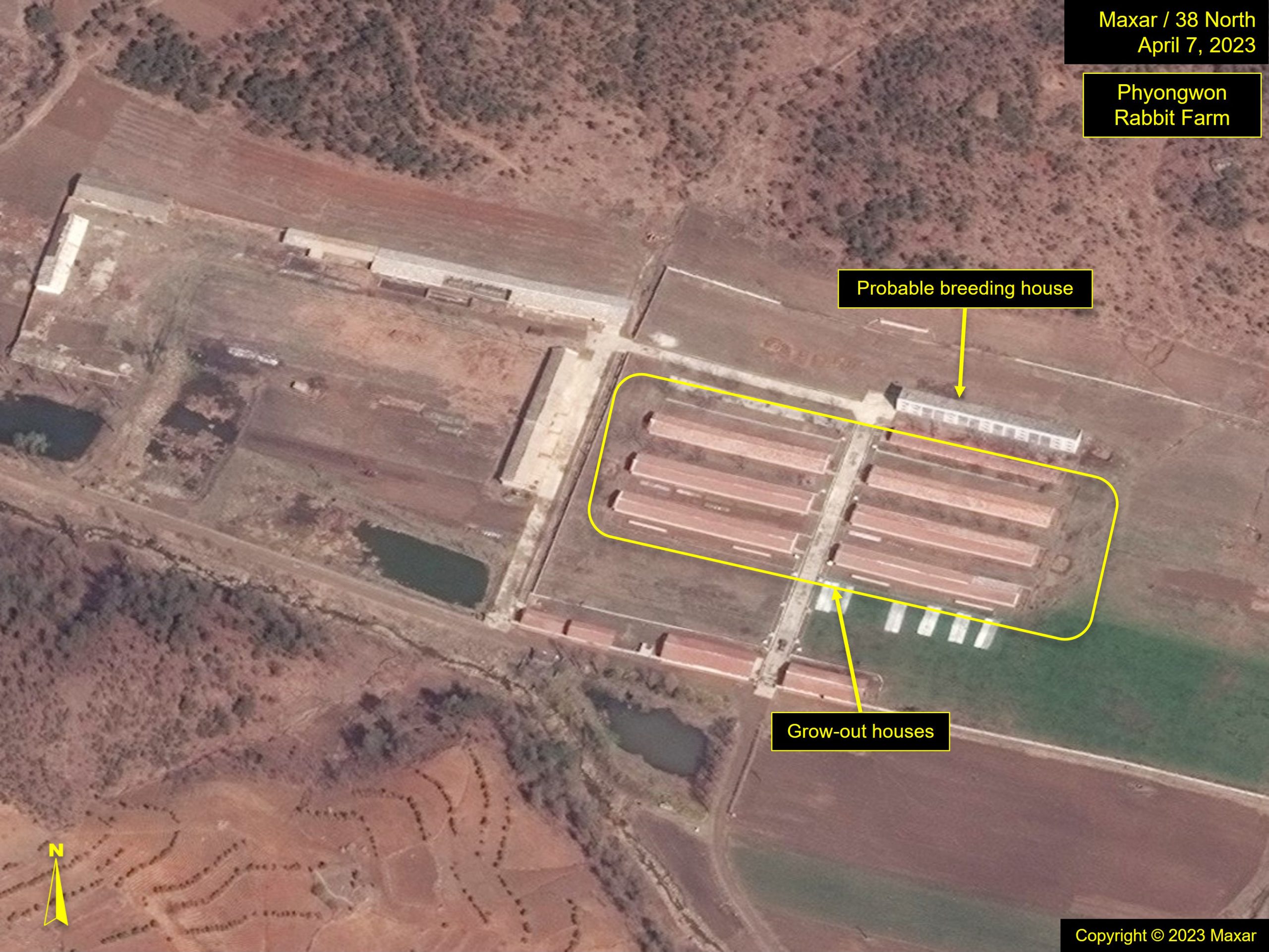
In 2021, state media highlighted renovations and worker housing construction at the farm, signaling further investment to expand the facility and its production. From 2010 to 2022, the total number of buildings fluctuated, perhaps due to modernization efforts or simply for restoration, but there did not seem to be an effort to expand production.
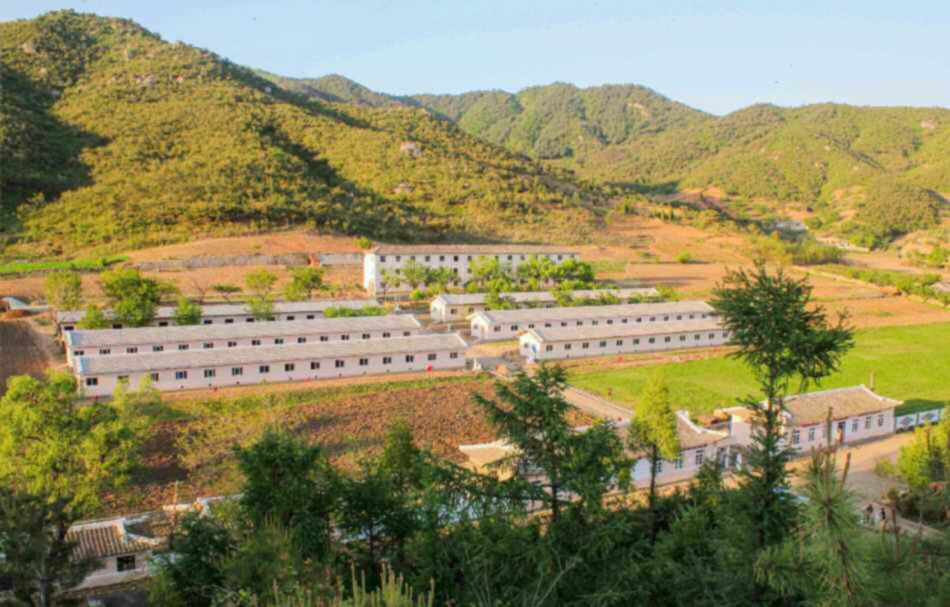
Pig Farming
Pig farming is not discussed as much as poultry or rabbits in North Korean plans or media. Of the known farms, there are four confirmed stand-alone pig farms located on the east coast; an additional two in the eastern mountains; 17 on the west coast; and another in the western mountains at Kanggye (Figure 5).
All the farms found on the eastern side of the country are more recent additions, with Hamju County Pig Farm being the earliest, constructed sometime between 2005 and 2007. The others were not added until 2013 or later. A potential explanation for this may be that fish protein has been dominant, as it is readily available to those along the east coast.
The west coast farms are older. Of the 18 located on the west half of the country, eight predate 2006, and four small pig farms have been constructed since 2018.
A sow can breed at around seven months and birth approximately 23 piglets a year. The gestation period is approximately 115 days, and she delivers a litter of 10 piglets. Each pig requires about eight square feet of space and is normally ready for market in about six months. Pigs are omnivores, eating much the same thing humans might eat, but this also puts them in competition for the same foods, albeit much of it is scraps. While each pig can provide a substantial amount of meat, the time and cost to raise for market make them a less common food choice.
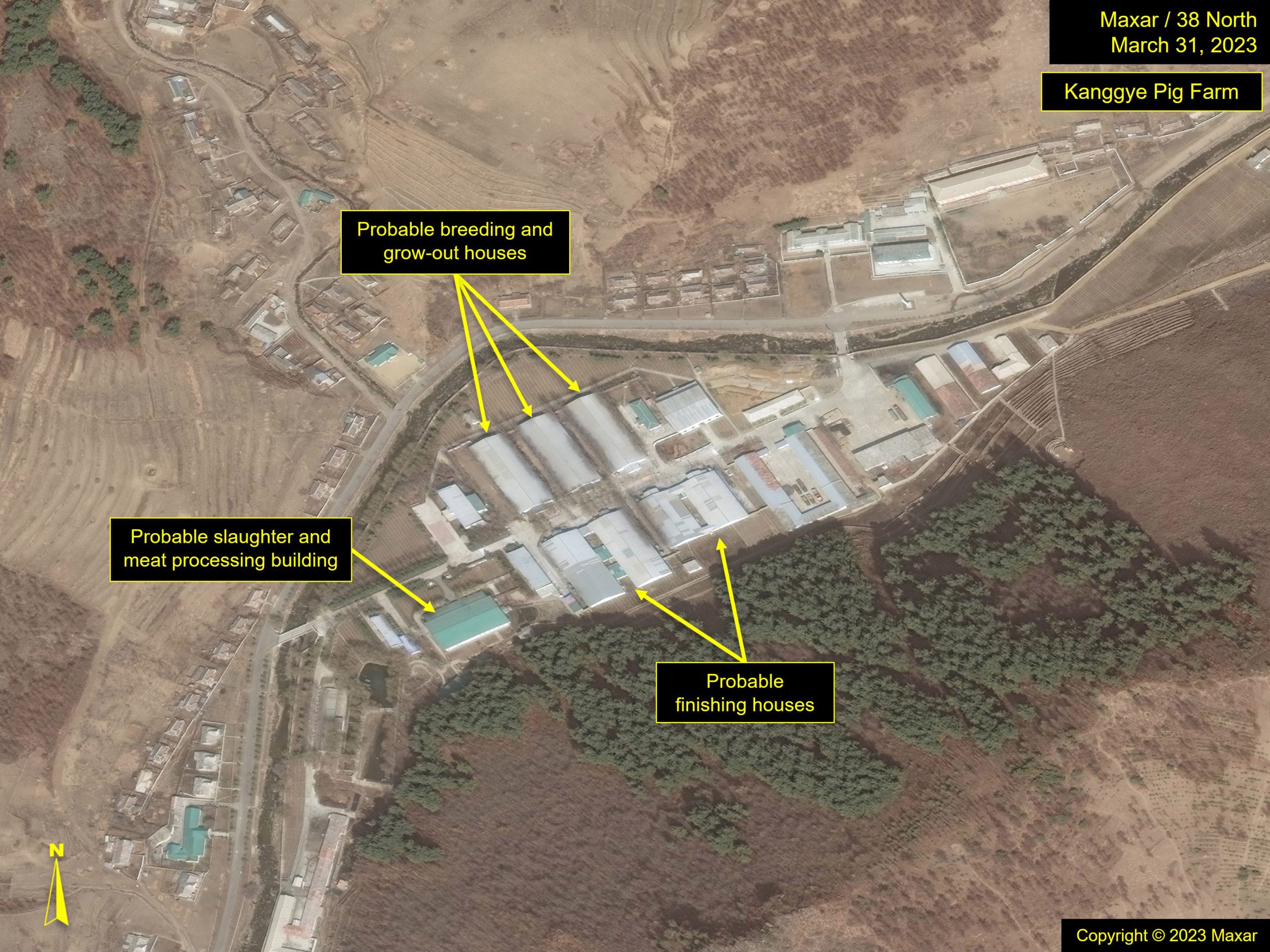
Grazing Animals
Grazing animals are those with diets that are principally grass. As such, they compete less with the grains and potatoes important to the diet of the North Korean population. While grasses can be found throughout North Korea, most of the lowlands are reserved for crops not suitable for growing in North Korea’s tablelands. However, grasses do thrive there, and because of this, the DPRK undertook a project around 2012 to turn the tablelands into grazing fields for the raising of larger livestock such as cattle, sheep and goats.
The transformation of the tablelands is documented in a previous Tearline report. Since the release of that report, little has been observed in the way of further growth of these farms. It is likely that efforts have, in recent years, been focused on expanding the herds of livestock with the farms from seed stocks to gradually fill each farm to capacity.
Fish Farming and Fisheries
Of the various animal protein sources available to North Koreans, fish are by far the most plentiful. Aquaculture, hatcheries and open sea fishing are each a contributor to the supply chain. As one might expect, the oldest and most productive has been offshore fishing.
At the same time, the availability of seafoods domestically has historically been constrained to certain parts of the country due in part to inadequate distribution channels and, before sanctions were imposed on this industry, a preference toward exports.
Exporting aside, today, North Korea has placed considerable emphasis on expanding and modernizing both its fishing fleet and fisheries and the number of its fish farms. In 2001, reportedly 200,000 tons were wild caught compared to 63,000 tons attributed to aquaculture. Around 2015, a sharp uptick in the number of fish farms began, and while no official numbers have yet surfaced, the latter number has likely grown significantly.[2]
Three of the larger fisheries on the east coast, Chongjin, Sinpho and Kim Chaek Taegyong, are frequently highlighted in state media. Others include Tanchon, Hongwon, Wonsan and Thongchon. Larger fisheries adjoin protected harbors and/or basins where boats can seek safe haven during the winter months and the typhoon season.
Chongjin Fishery Station
The Chongjin Fishery Station (Figure 6) is particularly noteworthy as it has been the subject of several articles published in North Korean state media. Chongjin, located approximately 330 kilometers from Wonsan on North Korea’s east coast, has a fishery station at the edge of the largest of three protected harbor areas, next to a basin of approximately 33 hectares in size. State media reported its construction in 2017, noting that the complex will contain “nearly 30 production buildings, including breed-fish ground, hatchery, fry breeding ground and fish food factory, and cultural and welfare facilities and offshore fish farms.”
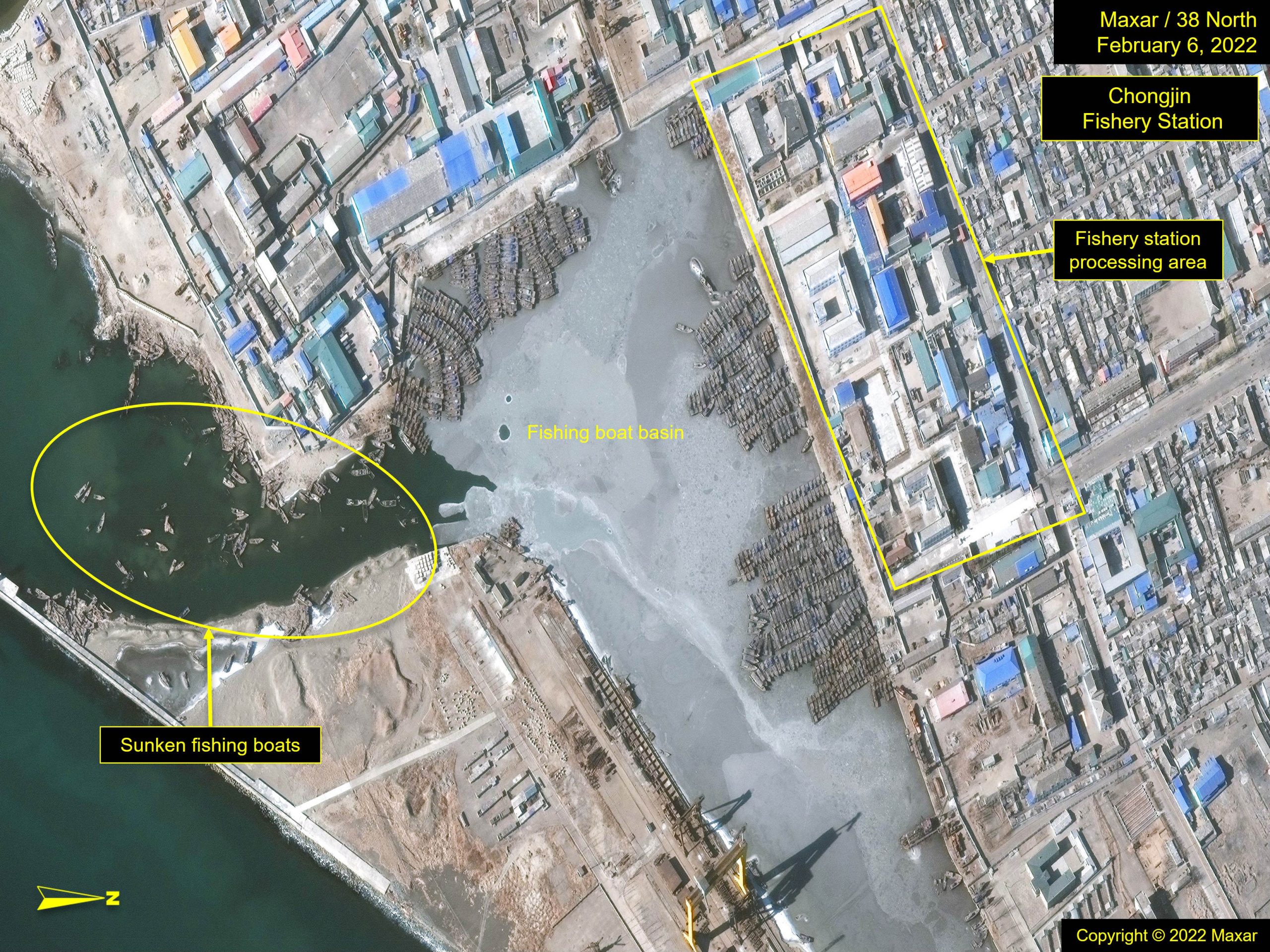
The site has also been a place of emphasis for a scientific approach to increasing fish capacity, examining and monitoring the quality of water and its temperature. Chongjin, along with other fisheries like Kim Chaek, have also been attributed to boats utilizing different fish-detecting means in their harbors.
The number of fishing boats that find shelter in the basin is impressive, and thus, their fluctuation in numbers appears to define the fishing season. These numbers range from a few hundred to several thousand boats during the wintering months and when the threat of a typhoon appears imminent. As such, the number present provides a bit of a bellwether for fishing activity.
Prime fishing season runs from June through September. By October, the basin begins to swell with boats, which are tightly arranged, making any rapid and orderly departure impossible.
Aquaculture
Aquaculture has been a staple in North Korea for decades. Most of the earlier fish farms made use of rice paddies and rectangular ponds adjacent to rivers. Tilapia, carp and catfish subsist on herbivorous diets, making them ideal for raising in these waters, whereas fish, such as salmon, subsist on other marine life, so sourcing food for them is more difficult. Under Kim Jong Un, greater emphasis has been placed on aquaculture and hatcheries.
The latter is intended to raise fish beyond the fry stage, which allows them to compete more successfully in open waters, thus, in theory, increasing the stock and, in turn, the catch. The hatcheries tend to be located near the coast.
Earlier farms took advantage of rice paddies to raise fish. In the past decade, more purpose-built farms have been set up. Fish that school can be held in tighter quarters, but there needs to be a constant flow of water circulating within the tanks or ponds where these fish grow.
Floating Fish Farms
There has also been the introduction of floating fish farms. These have the appearance of grid patterns placed on the water with net or wire cages arrayed beneath them underwater. These allow both water, natural food and nutrients to pass through them so the fish can feed naturally, they but are contained for easy harvest.
Floating farms can be found on rivers, lakes and in protected harbor areas, depending on the breed of fish being raised. On the west coast, these can also be found within the land reclamation areas where dikes are being extended into the sea to capture and contain silt deposits, a process which takes many years before the land can be planted, making them exceptional protected areas for aquaculture in the interim.
Floating farms are among the easiest to manage and maintain. These enclosures are each fitted with bows for stability in the fast-moving current. In the city of Kanggye, for instance, there are several protein-producing farms for livestock and fish. One of these fish farms is comprised of a series of six floating fish enclosures positioned at various points along the Changja River, built between 2017 and 2018 (Figure 7). The river provides a natural habitat for the fish, but it comes with a downside, as seasonal droughts and flooding can impact farming operations.
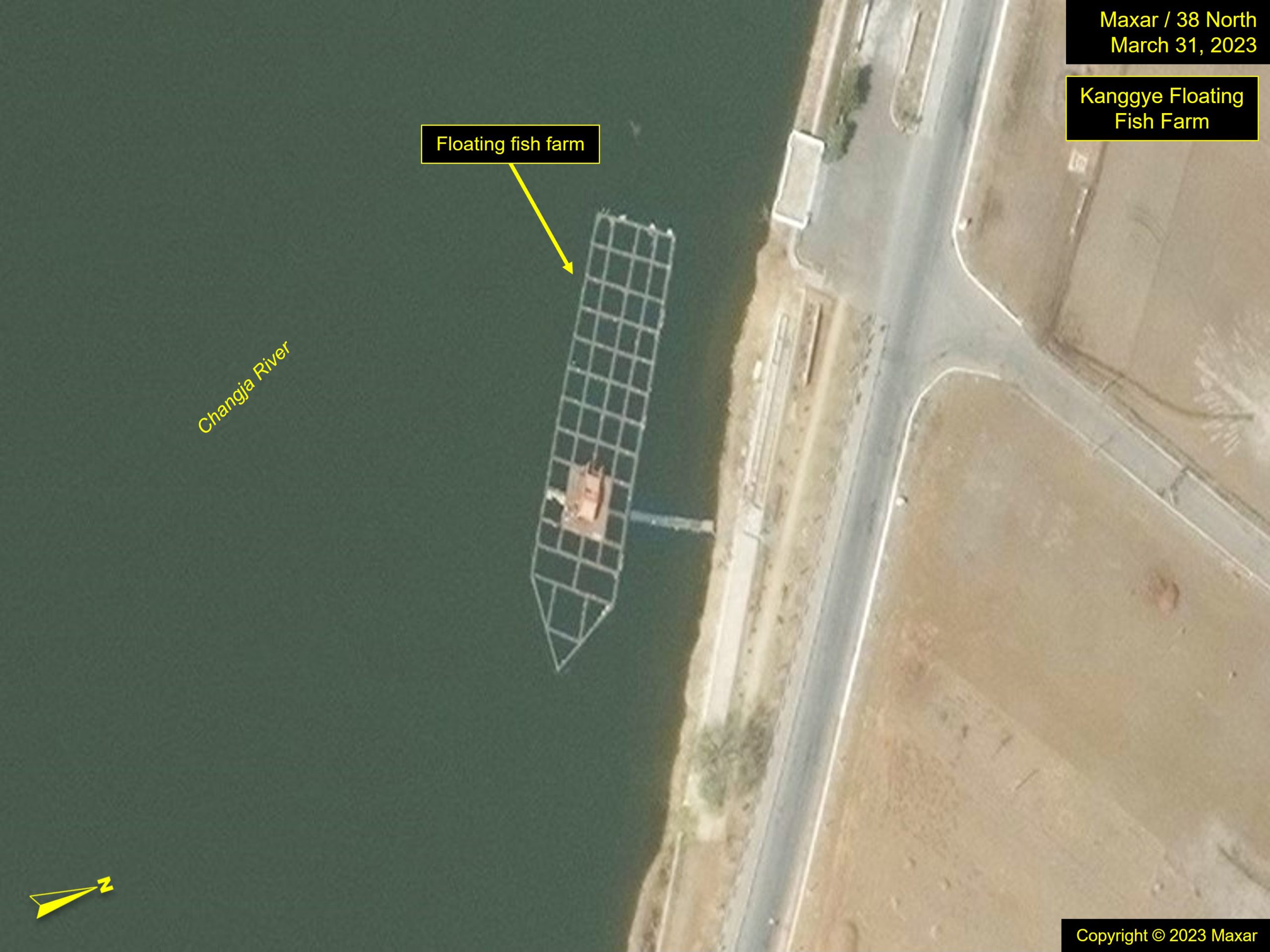
Myongchon Catfish Farm
Myongchon Catfish Farm (Figures 8-9) is an exemplar of a modern catfish farm layout. Construction on the farm began in July 2017 but did not reach completion until October 2019. It is unclear as to why the slow progress, but other, newer fish farms followed a similarly slow pace.
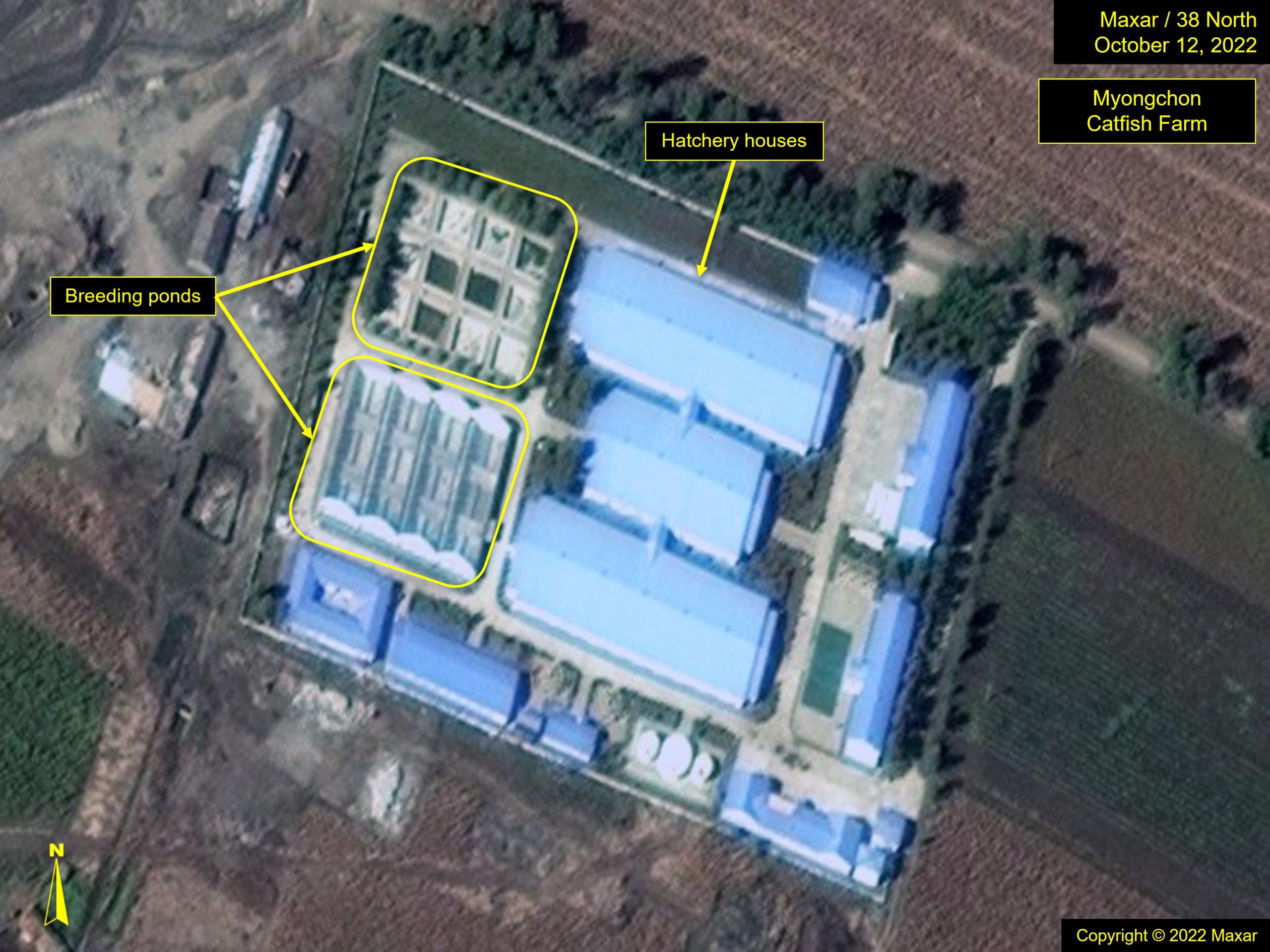
Jikha Atlantic Salmon Pedigree Farm
Chongjin boasts one of the newest salmon farms, the Jikha Atlantic Salmon Pedigree Farm (Figure 10). It is fitted with a number of tanks allowing for the breeding and separating of fish by size—fry, fingers (small fish) and the maturing larger fish held in growing-out tanks.
Work to build the farm began in August 2016, but construction on the six tank houses stalled until tanks were observed being placed with the first of the six in May 2020. The roofing for all six was not completed until late 2022. While several buildings (possible administrative and laboratory buildings) were completed in December 2017, the reason for the lengthy pause in construction on the remaining buildings is unknown.
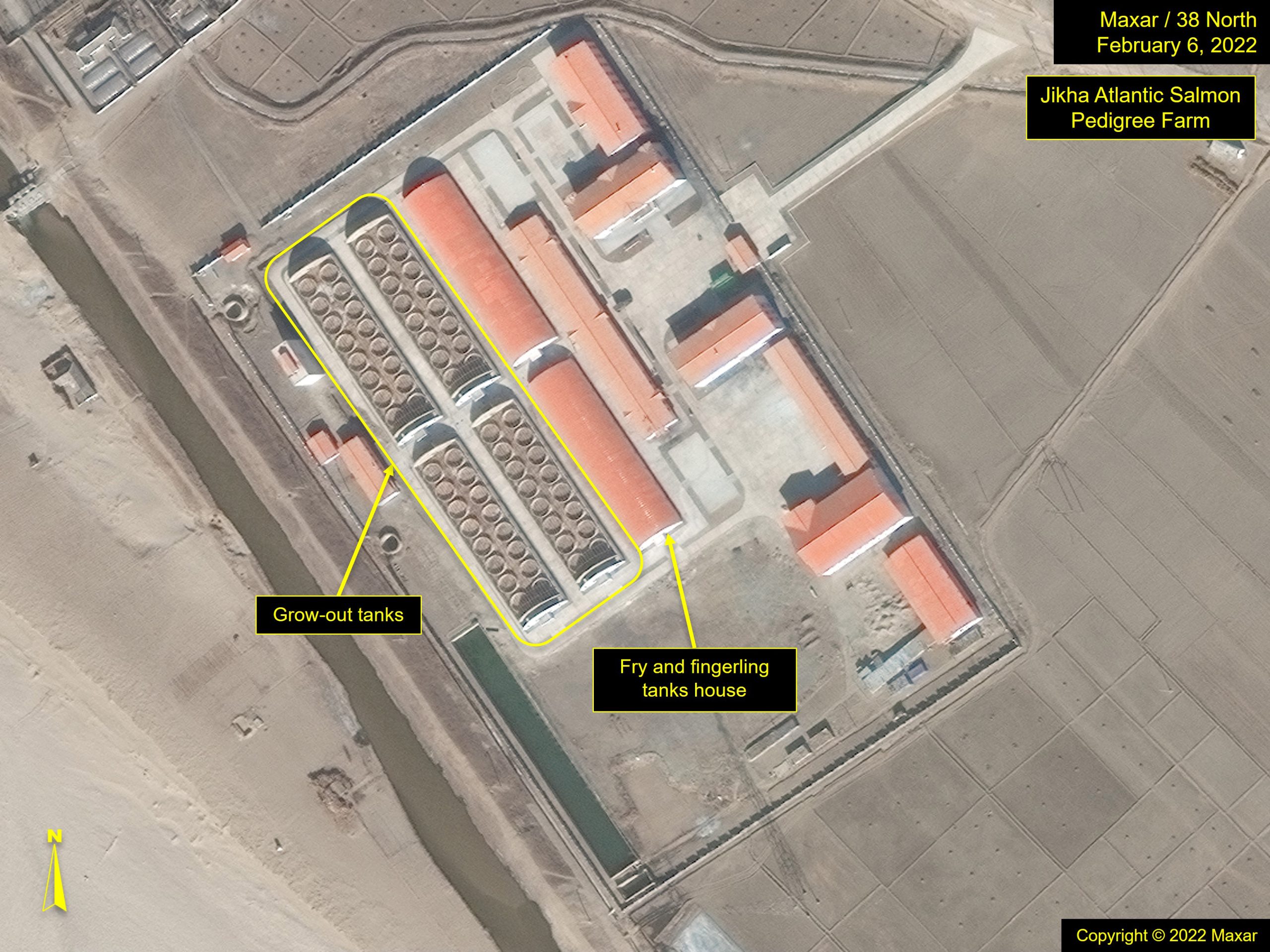
Conclusion
Based on North Korean rhetoric, increasing protein production is a priority endeavor, where malnutrition is chronic and food security can vary. It is unclear, however, how successful these efforts have been, given our dependence on external sources such as satellite imagery.
At the facilities the government has selected as exemplars, positive changes can, in most cases, be observed, at least in the building and sometimes expansion of livestock or fish farms. However, how full these farms are and their actual output is still an open question.
Moreover, efforts to modernize or expand older farms are not as apparent. This begs the question as to whether the addition of new, modern farms will continue and at what pace?
Looking Ahead
Assuming the DPRK continues to emphasize increasing animal protein availability, then the following should be monitored.
Things to Watch
- New fish farms, both along the coast and inland on lakes and rivers.
- The addition of new grow-houses in poultry, rabbit, and pig farms.
- The continued addition of new farms in the step lands.
- New livestock farms, with more cookie-cutter architectural signatures.
- Is the growth in livestock farms uniform, or is there an apparent preference for certain animal protein?
Data Sources
kml Highlighted DPRK Protein Sources
shp Highlighted DPRK Protein Sources
The Stimson Center and the National Geospatial-Intelligence Agency partnership uses unclassified imagery and data to produce new, timely, and accurate reporting on the North Korean economy. For more info, read the Tearline Project Explainer.
To read more, visit NGA’s Tearline article or download the Tearline app from the Apple Store or Google Play.
This content also syndicates to the Office of the Director of National Intelligence’s website intelligence.gov, which is a transparency effort to better explain certain strategic and humanitarian IC missions to the public.
- [1]
A hen begins to lay eggs between 16 to 20 weeks. If her eggs are not fertilized, she may lay as many as 300 eggs in a year. After 25 weeks, however, her productivity begins to decline, and in most cases, they would go to slaughter in about a year. Not all the chickens will be brooders, and not all will be raised for their eggs, leaving a third category called “broilers,” which are grown for their meat and reach an appropriate size for slaughter at between five to nine weeks.
- [2]
David Kang, “The Economy,” In North Korea: A Country Study, ed. Robert L. Worden (Washington, DC: Library of Congress, 2008), 133–180.

